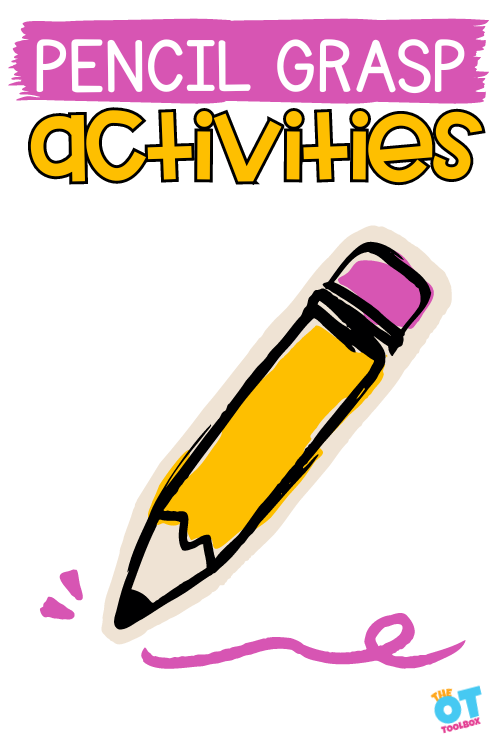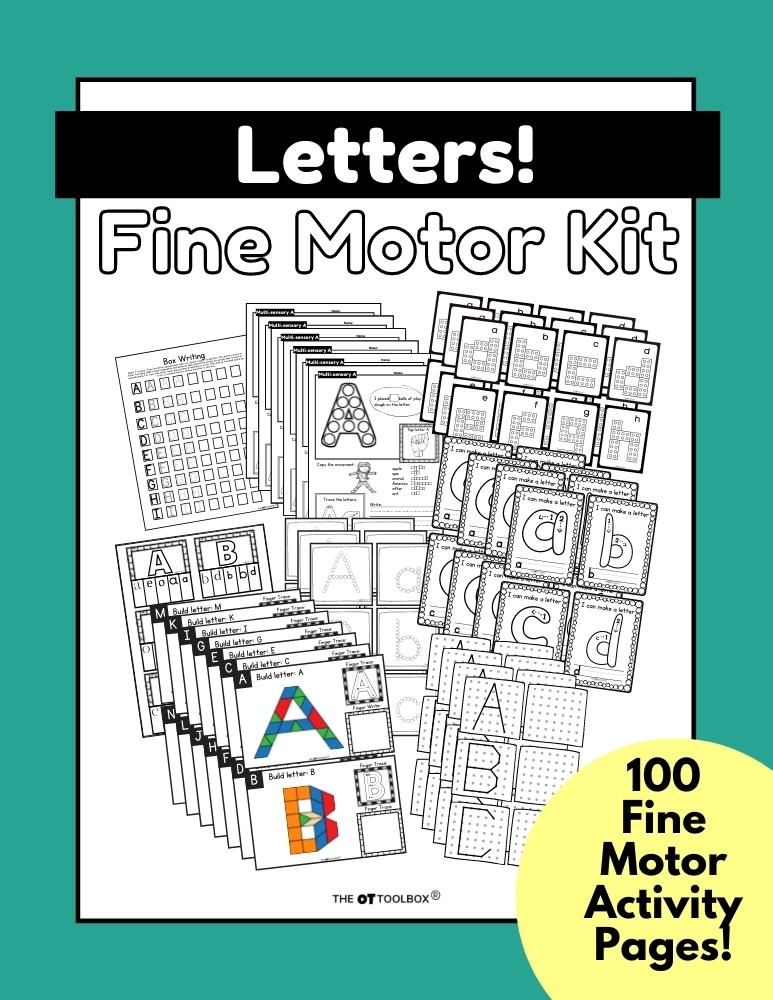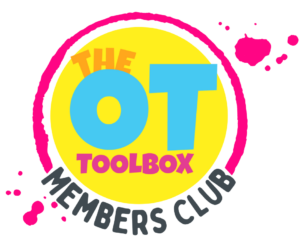This blog discusses activities for teaching letter recognition. At its most basic, letter recognition refers to letter identification. It is one of the main skills children need to know before they can name, write, or sound out the letters. The following fun letter recognition games for preschoolers are based on development and skill progression.
Be sure to read through our blog post on name practice for kindergarten for resources and tools to support letter use and recognition in children ages 5-6 or for kids at the level where they are recognizing letters in their name. These ideas are great for beginning reading for kindergarten.
Use our new color by letter worksheet to further develop this letter recognition skill.
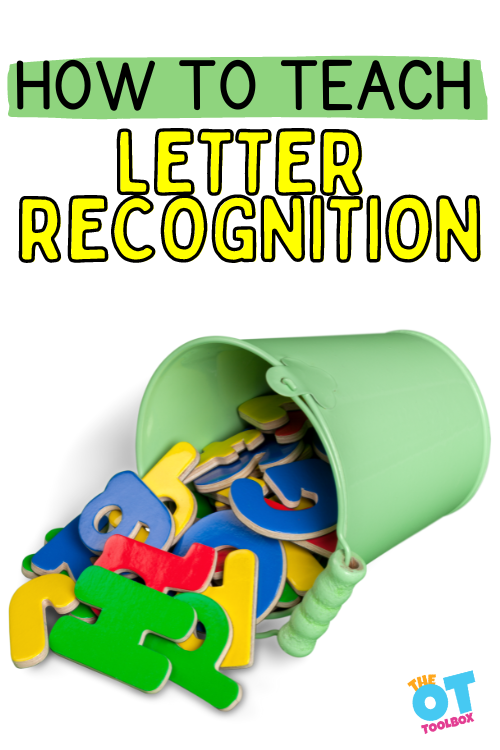
What you need to know about Teaching Letter recognition
Letter recognition, or the ability to recognize and identify letters begins at a very young age. But did you know that teaching letter recognition skills starts way before kindergarten and and even before entering the classroom?
Kindergarten students are many times exposed to writing and copying letters on trace worksheets, and writing pages. But before a young child can do these skills that are part of the curriculum, knowing what skills lead up to these skills is helpful.
Even before a young preschooler is able to identify and name letters in printed context such as books or letter play activities, they are learning this skill through the immersion of seeing letters in everyday life.
Letter identification and the ability to recognize letters in printed form might occur through exposure on television, printed media, following along while a book is being read, or while engaging with technology.
There is a progression in the important literacy skill of recognizing printed letters:
- Letter recognition in isolation – example, pointing out all of the upper case letter As on a letter picture book
- Letter recognition in every day life – example pointing out the letter S on a stop sign
- Letter identification – identifying and stating letter’s names
- Letter identification in text -reading and sounding out a letter’s sound in reading or sounding out written text
- Matching upper case and lowercase letters– matching the upper case letters to lowercase, and vice versa
Each step of teaching letter recognition skills is founded in experience and practice. This includes communication with others, exposure, and reading with caregivers.
Not every child learns the same way. Starting as young as preschool, caregivers can support children by using their interests and strengths to teach them new skills.
Children don’t need to read or write until well beyond toddlerhood, but preschoolers enjoy looking at books, finding letters on walks, and learning letters through movement.
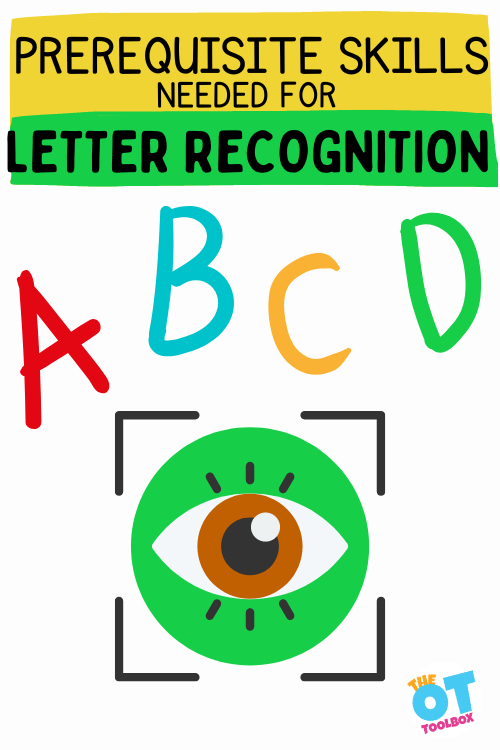
Prerequisites to Letter Teaching Letter Recognition
Several areas are needed to develop letter recognition skills:
- Object permanence
- Form constancy
- Visual discrimination
- Visual figure ground
- Working memory
- Visual memory
- Visual scanning skills
- Cognitive skills
- Physical development
You can see that these components are founded in visual motor skills, perceptual skills, and working memory.
Before any of this can happen (and through the process), young children should be exposed to rhymes, songs, and singing the alphabet song. (Add alphabet exercises for movement fun!) Letter formation rhymes can support literacy as well. This is actually the first step in the road to literacy!
Teaching letter recognition requires Visual discrimination Skills
Letter recognition/identification is when a person is able to look at a letter and recall it from previous experience. Recognition of letters occurs both in uppercase and lowercase form. Additionally, there is a cursive letter recognition aspect as well. This blog post covers cursive letter recognition skills.
This site states that even before letter identification, there are a few other skills that should be taught, including visual discrimination, so the child is able to find differences among lines and shapes.
Visual discrimination can be taught in isolation through books or letter formation worksheets, or in games and activities such as Memory games, matching and sorting activities, or playing “what’s the same” and “what’s different” through hidden picture activities and puzzles. We cover this visual perceptual skill in our blog post, Wacky Wednesday book activity.
Visual Memory Another great play-based activity to develop the visual perceptual memory skills needed for letter recognition, are games that challenge kids to notice differences. Present the child with a tray of everyday items, and ask them to memorize the items on the tray. Ask them to look away or cover their eyes. Take away one or more items, and have them recall the missing items.
Letter activities- Other ways to encourage letter play is through printed alphabet worksheets, puzzles, letter magnets, or other alphabet manipulatives such as letter beads. You can ask the child to sort letters based on shape, such as those that include straight lines, versus curved line, or diagonal letters. You can also sort letters by letters based on size: tall letters, short letters, and letters with a tail that hangs below the lines.
One way to encourage functional handwriting is through addressing letter size. This tall and short worksheet has a fine motor and visual motor component that can be incorporated into whole-body movement activities to teach these concepts that carryover into letter sizing and use in handwriting.
Prerequisites to teaching letter recognition begins in infancy
These prerequisite skills that support letter recognition, such as visual discrimination and memory, develop as early as infancy, when young children identify 3D objects that are familiar to them like their bottle, favorite toy, or their parents. It is important infants experience tummy time in order to develop visual motor skills, and strong oculomotor skills, as a result of time spent on the belly while looking at objects.
As children grow, their visual discrimination becomes more refined and they are able to identify pictures and written words.
Toddlers are able to point to a picture of a puppy in a book they are reading, or identify who is hiding under the blanket.
Object permanence and working memory
When a child sees an object and knows what it is called, this is referred to as object permanence. This requires working memory skill development to use what is seen, remember it, and store it for later retrieval.
While visual discrimination is the ability to detect differences and similarities in size, shape, color and pattern, cognitive ability is necessary to recognize these differences based on previous exposure, along with memory to have stored that information away in their mind’s eye to recall when needed.
This skill is typically associated with letter formation and handwriting skills. Identifying and discriminating between differences in letters allow kids to copy and write letters from memory. However, noticing and identifying the differences in the curves, diagonal lines, and lines that make up a letter are essential build up to that skill.
Hearing and saying the letter sounds associated with letters are part of the process, too. Phonemic awareness is developed initially through play, but this skill continues to develop and progress as reading and literacy skills are refined in kindergarten, first grade, second grade, and beyond.
Teaching letter recognition begins with the ability to recognize details in visual images
In more depth, students should identify likeness and differences of shapes or forms, colors, as well as the position of various objects and people. Developing discrimination skills will help children learn the alphabet and then both read and print letters a lot better.
There are numerous types of visual discrimination that children should begin to understand and develop. These include:
- 3D Objects
- Shapes
- Drawings & Pictures
- Colors
- Letters and Words
- Sequences
Letter recognition games
The letter recognition activities and games and listed below are fun ways to instruct children in the essential skills needed for reading and literacy. It’s literally the building block to reading.
- Name Recognition- Start with recognizing the letters of their name. Point out letters in the child’s name and ask them to point to letters in a book or on a sign. Children can first begin with recognizing upper case letters of their name, then moving onto the lowercase letters. Working first with uppercase letters is best, because capital letters are easier to discriminate between. Lowercase letters have many similar letters, b,d,p,g,q, and j.
- Bean Bag Letter Toss – Affix upper and lowercase letter stickers to one side of each bean bag. Put a basket or bucket across from your child. As your child throws the bean bags into the bucket, ask them to name the letters and their sounds of the letters. Students can run around looking for matching letters scattered around the room.
- Alphabet Play dough- Write down large letters on a piece of paper and place that paper into a sheet protector. Encourage your child to form the letters on the sheet protector with play dough of their choosing.
- I Spy Letter Walk –Take a walk with your child and look for letters in their environment such as on license plates, street signs and building. Play, I Spy, searching for different letters, or letters in sequential order. The printable tools in the Letter Fine Motor Kit are a great resource for this activity.
- Jumping to letters – Create a letter pathway with sidewalk chalk on a playground or sidewalk. Children can walk, run, jump, or crawl across the letters, naming them as they move forward! Change it up by asking them to walk backwards along the path. This is a fun motor planning activity.
- Chasing the Alphabet – (Amazon affiliate link:) Sammy Chases the Alphabet is a book I wrote about Sammy the Golden Dog playing fetch with balls around his farm. Each ball has a letter on it. After you read the book, bring the story to life by adding letter stickers to ball pit balls. Toss the balls around a room or outside, and encourage your child to find them all, naming the letters on each ball they find.
- Food Alphabet Worksheets – Pair real food items with these food worksheets. These worksheets include the letter, a food that starts with the letter, and all of the letters that make the word. As children sound out each letter, ask them to point to the letter that makes that sound.
more letter recognition Activities
Alphabet activities like the ones below support recognition skills through repetition. Alphabet recognition occurs through songs, play, and hands-on activities.
- The Soundabet Song – Letter identification doesn’t just include what letters look like, it also includes what letters sound like. Can your child point to the letter name as well as the sound it makes? This Soundabet Song is a great way to teach kids how to pair the sounds of the letters to what the letters look like.
- Letter Push – This ABC play dough activity uses plastic letters and play dough! Add in some fine motor skills to alphabet identification, by having children push plastic letters into play dough while they name the letter. This can be done as a circle time game, where each child take a turn pushing in a letter, or a small group time where every child has the opportunity to push the play dough letters.
- Alphabet Sensory Bins – Nothing keeps my preschoolers entertained more then a large sensory bin! Adding alphabet letters or letter markers to the sensory bins for children to find and match, is one of the most exciting letter identification games. Check out these sensory bin base ideas to use in different letter recognition sensory bins.
- This alphabet sensory writing tray requires users to recognize letters by uncovering them from a sensory medium. This is a great activity for recognizing letter parts such as diagonals or the curved part of a letter as the letter is uncovered.
- Metal alphabet tray play – My favorite is to add a metal pan to the sensory table, and ask kids to stick the magnet letters they find in the sensory materials onto the metal pan!
- Alphabet Discover Bottle – This sensory discovery bottle can be used before naptime, bedtime, in a calm down corner, or as a learning activity. As children shake the bottle, they can name the letters that appear!
- Match letters- Match uppercase letters to lower case letters, match different fonts of letters, and match letters in different environments (books, signs, on television, in print, etc.)
- Gross motor activities- Use a letter floor mat to jump on a specific letter. Ask the child to find a letter magnet and place it on the letter mat.
- Letter recognition scavenger hunts- Use ideas like these letter clothes pins scavenger hunt for ideas.
- Write letters in shaving cream or in sand
- Sort letters by word families when teaching letter groups
- Play beginning sound games- I spy with my little eye, a word that starts with /b/
- Use dot markers to dot letters
- Spot letters on a white board and trace with a dry erase marker
- make letters from pipe cleaners
- Sensory play activities
- Trace letters on sandpaper
A note teaching letter recognition skills:
Learning through play doesn’t have to be stressful. Every child learns differently, and that includes recognizing letters of the alphabet. Once a child has developed the visual discrimination, expressive language and receptive language skills needed to participate in letter identification activities, notice what motivates them to learn.
Do they like to move, cut, color, dance, or sing? Pick a letter activity that you know your child will love, and they will keep coming back for more. This will result in increasing their attention span and learning new letters daily. Follow your child’s interests and you will surely have a wonderful time!
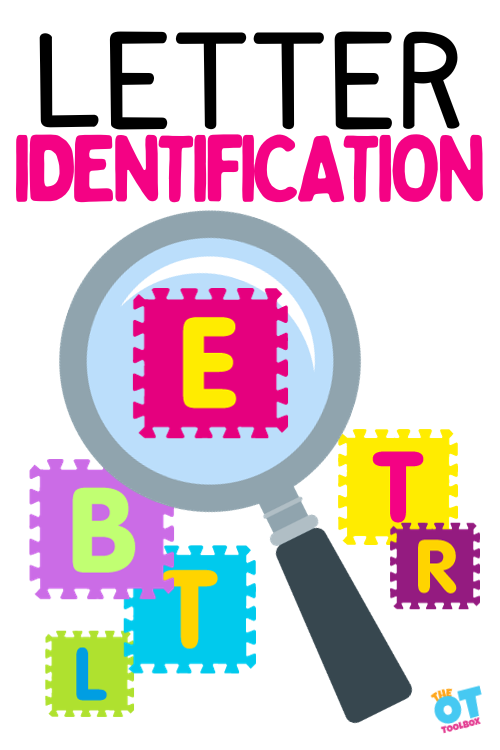
Today’s post addresses Letter Identification. What happens if your student copies letters, but is unable to recognize them? Can a student who can not identify letters learn to read? Letter identification is at the core of reading and writing, which are important life skills.
letter identification before copying and tracing
Many therapists and teachers work on copying and tracing long before their students can recognize the letters. Have you thought about what happens if your student copies and traces letters, but is unable to identify them?
Tracing is not going to teach number/letter formation if the learner does not know what those figures are. To a learner who does not know these symbols, they will be tracing lines and circles, not learning numbers or letters.
This holds true for copying letters and numbers. For example, the “H” becomes just sticks, while the “b” is a ball and a stick rather than recognized symbols.
Theoretically if a person writes or traces the letter “A” enough times, the body will start to recognize this pattern (through motor planning and kinesthetic awareness), and commit it to memory.
This only works if the learner understands what is being traced or copied, and can add meaning to it.
can a student who is unable to identify letters learn to read?
Sadly students who are unable to recognize letters can learn to read, but not efficiently or effectively. Learners who are unable to identify letters will memorize the way words look as a clump, rather than using letter identification and phonemic awareness. This holds true for math. Students can learn ways to get around multiplication and division without memorizing these facts.
Because students can “get by” this is why it is critical to insure students have the necessary building blocks for learning before moving on. Pushing students through to the next grade without having the necessary skills, is an ongoing problem. How many high school students have you seen that are unable to do simple math in their head, or spell simple words? Too many.
IdentificATION OF lETTERS FOR READING
Let’s circle back to letter identification now that you have a better understanding of the need for letter identification before teaching reading, copying, writing, or tracing.
One of the pre-reading skills kids need to be a successful reader is letter knowledge.
Letter Knowledge begins with Letter Identification which is also known as Alphabet Recognition.
Students have different learning styles, therefore they need to be exposed to new information in various ways.
Learners can understand information by:
- visual- Read about how visual impairments impact learning
- auditory- Read about auditory learners here.
- kinesthetic- Here is information on kinesthetic learning
- reading/writing instructional methods
Offering several different teaching styles is the key to meeting the needs of all different types of students. Sometimes this takes many trials to find the one that sticks.
I had a reluctant learner who was unable to recall or identify his letters despite repetition, flash cards, games, puzzles, worksheets, or any other activity I presented. In the past I had used my students specific interests to spark their learning. Many lines were made making Thomas the Train tracks across the paper.
This student loved Star Wars. He could name every character. Lucky for me, there are many Star Wars characters! I paired a letter with each character. We used A for Anakin, S for Stormtroopers, C for Chewbacca, and so on. At first we worked on pairing them verbally/auditorily. Then I made flash cards with pictures of each character near their name and picture. Because this was motivating for him, my student quickly learned letter identification!
activities to teach letter idenfication
Before children are able to learn to read or identify letters, you can work with them to understand what they are. This can be done by reading stories, singing songs, telling nursery rhymes, and talking to them. Once they begin to notice that stories or other items have symbols, you can point to the words as you read them. Here are some simple letter identification activities:
- Point out print wherever you see them. On signs, license plates, television, books, packages, clothing, or anywhere you might find written print.
- Look for specific letters in books or magazines. Ask the child to name the letter and the sound.
- Make arts and crafts with specific letters. Write it in sand, shaving cream, or a foggy mirror. Letter of the week crafts are fun, too. We have printable letter crafts inside The OT Toolbox Membership.
- Practice writing letters with different toys or activities. Magnetic letters, books, magazines, puzzles, flash cards, and games like Scrabble, are handy options to have letters readily available for letter identification.
- Form letters out of pretzel dough, play dough, popsicle sticks, pasta, or cookie cutters for sensory letter formation.
- Play a Letter Scavenger Hunt and have students look for certain letters you have hidden around the room or house. A scavenger hunt is another great use for magnetic letters. Enhance this activity by adding finding items that start with that letter.
- Use a keyboard to identify letters. Keyboarding skill is a great life skill tool to have. Finding and identifying letters is a great way to practice and learn the letters in a functional way.
ot toolbox resources for letter recognition
- Developmental tools for teaching letter recognition – This blog discusses activities for teaching letter recognition
- Here is a recent post on Learning Letters with Bottle Caps
- The OT Toolbox Archives contain dozens of posts related to letter recognition.
- Alphabet Movement Cards – Alphabet Movement Cards combine love of letters, along with aerobic activity to work on muscle strength, tone, focus, attention, or add a much needed sensory break between tabletop tasks.
- Letter Formation Themed Activities – This page includes all of our Letter Formation theme activities. You’ll find letter formation themed fine motor activities, letter printables, and A-Z therapy tools of all kinds! Plan out a week (or weeks) of activities for your whole therapy caseload. Just print and go!
Letters are everywhere!
When you start to think about letters, you realize they are everywhere! Use what is readily available to immerse your learners in knowledge. You might have to get creative once in a while, like my Star Wars guy, but that is what makes this job so fun!

Jeana Kinne is a veteran preschool teacher and director. She has over 20 years of experience in the Early Childhood Education field. Her Bachelors Degree is in Child Development and her Masters Degree is in Early Childhood Education. She has spent over 10 years as a coach, working with Parents and Preschool Teachers, and another 10 years working with infants and toddlers with special needs. She is also the author of the “Sammy the Golden Dog” series, teaching children important skills through play.
The Letter Fine Motor Kit is a 100 page printable packet includes everything you need for hands-on letter learning and multisensory handwriting!
This resource is great for pediatric occupational therapists working on handwriting skills, fine motor skills, visual motor skills, and more. Use the activities to promote a variety of functional tasks.
Teachers will find this printable packet easily integrated into literacy centers, classroom activities, and multisensory learning.
Parents will find this resource a tool for learning at home, supporting skill development, and perfect for therapy at home!
MULTISENSORY HANDWRITING
Grab the Letter Fine Motor Kit and use all of the senses, including heavy work, or proprioceptive input, through the hands ask kids build and manipulate materials to develop handwriting and letter formation skills.

